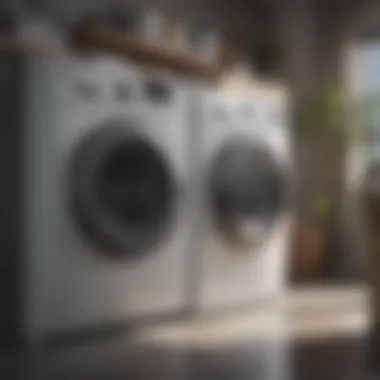Expert Tips for Streamlining Your Laundry Room Organization Effortlessly


Materials:
In order to embark on the journey of decluttering and optimizing your laundry room, you will need to gather a variety of materials that will aid you in this endeavor. Here is a detailed list of the items you will require:
- Storage Bins: Get durable, stackable storage bins in varying sizes to categorize and store different items effectively.
- Hanging Rods: Install sturdy hanging rods to hang freshly laundered clothes or items that benefit from air-drying.
- Labels and Marker: Invest in labels and a marker to clearly mark the contents of each storage bin for easy identification.
- Shelves: Consider adding shelves to maximize vertical space and keep frequently-used items within reach.
- Drawer Organizers: Purchase drawer organizers to sort smaller items like socks, undergarments, or laundry accessories efficiently.
- Folding Table: If space allows, a folding table can be beneficial for folding clothes or organizing laundry essentials.
- Laundry Sorting Baskets: Opt for multi-compartment laundry sorting baskets to pre-sort clothes by color or fabric type.
By ensuring you have these essential materials at hand, you will be well-equipped to tackle the decluttering process effectively and efficiently.
Understanding the Importance of a Decluttered Laundry Room
A clutter-free laundry room is more than just visually appealing; it plays a vital role in enhancing functionality, improving efficiency, and reducing stress levels. By decluttering this space, you create an environment that fosters ease of movement, accessibility to essential items, and overall productivity. Enhanced functionality is key in a decluttered laundry room as it allows for a seamless workflow and a well-organized area that simplifies tasks. Improved efficiency is another crucial aspect that ensures you can perform laundry duties with speed and precision, avoiding unnecessary delays. Reduced stress is a significant benefit of having a decluttered laundry room, as the calming environment promotes a clear mind and lowers anxiety levels.
Setting Clear Goals for the Decluttering Process
When embarking on the decluttering journey for your laundry room, it is essential to set clear goals to achieve optimal results. Start by identifying problem areas that hinder efficient usage of the space. Prioritize these areas based on their impact on your laundry routine, ensuring that the most critical issues are addressed first. Establishing priorities allows you to focus your efforts effectively, tackling the most pressing clutter concerns methodically. Creating a realistic timeline is crucial to maintain momentum and ensure that the decluttering process stays on track. By setting achievable deadlines for each task, you can avoid feeling overwhelmed and track your progress effectively throughout the decluttering project.
Preparation
In the realm of optimizing one's laundry room, the Preparation stage serves as a pivotal cornerstone in achieving functionality and organization. Before delving into the cluttered affray of the laundry space, one must first arm themselves with the necessary tools and strategies essential for a successful decluttering endeavor. This section sheds light on the significance of thorough preparation and how it sets the tone for the entire process.
Gathering Essential Supplies
When embarking on the journey to reinvigorate your laundry room, the importance of acquiring the right supplies cannot be overstated. Strategically selecting bins and baskets lays the foundation for an efficient storage system, enhancing accessibility and tidiness. Labels and markers play a fundamental role in categorizing items, facilitating orderly placement and quick identification. Utilizing suitable cleaning products ensures a hygienic and pristine environment, contributing to a harmonious laundry space.
Bins and Baskets
Bins and baskets, the unsung heroes of organization, offer a seamless solution for storing various items in the laundry room. Their versatile nature allows for easy segregation of distinct categories, fostering a systematic approach to clutter management. With durable construction and ergonomic designs, bins and baskets prove to be both practical and aesthetically pleasing additions to the space, enhancing its overall appeal and functionality.


Labels and Markers
In the arsenal of decluttering tools, labels and markers emerge as indispensable assets for creating a structured sorting system. The clarity provided by labels ensures that items find their designated places, eliminating confusion and expediting the retrieval process. Marking containers with pertinent information enhances efficiency, minimizing time wastage and optimizing storage utilization. While labels streamline organization, markers add a personal touch, instilling a sense of ownership in the decluttering journey.
Cleaning Products
A pristine laundry room not only elevates the ambiance but also contributes to a healthier living environment. Cleaning products tailored to specific surfaces and materials aid in maintaining cleanliness and hygiene standards. By selecting high-quality detergents, wipes, and sprays, one can combat dirt and grime effectively, fostering a fresh and inviting atmosphere. Incorporating eco-friendly cleaning solutions aligns with sustainable practices, promoting both the well-being of the space and the planet.
Creating a Sorting System
Central to the process of decluttering is the implementation of a robust sorting system, establishing order amidst chaos. Categorizing items into distinct groups streamlines decision-making, allowing for targeted organization and storage solutions. Designating zones within the laundry room delineates functional areas, optimizing workflow and enhancing accessibility. The donateselltrash strategy offers a comprehensive approach to decluttering, enabling individuals to dispose of unnecessary items responsibly and ethically.
Categorizing Items
Categorizing items according to their utility and frequency of use enhances the efficiency of the laundry room. By grouping similar items together, individuals can create designated spaces for each category, minimizing clutter and promoting a structured environment. Storing frequently used items within easy reach and relegating less-used belongings to higher or lower shelves optimizes storage capacity, leading to a more organized and visually appealing space.
Designating Zones
Segmenting the laundry room into distinct zones based on functionality enhances workflow and task efficiency. Designating areas for sorting, washing, drying, and folding streamlines the laundry process, reducing unnecessary movements and optimizing time management. Incorporating designated spaces for supplies, such as detergents and fabric softeners, ensures easy access during laundry tasks, promoting a seamless and enjoyable experience.
Implementing a DonateSellTrash Strategy
The donateselltrash strategy offers a comprehensive framework for decluttering possessions responsibly and purposefully. Items that no longer serve a functional purpose can be either donated to those in need, sold to recoup value, or disposed of in an environmentally conscious manner. Implementing this strategy fosters a culture of mindfulness and sustainability, promoting conscious consumption habits while decluttering the laundry space effectively.
Execution
In the realm of executing the laundry room decluttering process, precision and methodical actions hold paramount importance. This pivotal stage bridges the gap between planning and tangible results, where strategies unfold into actualized changes within the space. The meticulous approach to execution ensures that every step taken aligns with the overarching goal of creating a streamlined and functional laundry area. By implementing the right techniques and utilizing available resources efficiently, the execution phase becomes a transformative journey towards an organized and clutter-free environment.


Decluttering Techniques
The KonMari Method
The Kon Mari method, a renowned decluttering approach popularized by Marie Kondo, emphasizes the transformative power of tidying up by focusing on items that spark joy. This method underscores the significance of only keeping possessions that resonate positively, thereby reducing unnecessary clutter and promoting a mindful selection process. Its distinctive feature lies in creating a connection between individuals and their belongings, fostering a harmonious and clutter-free living space. While the KonMari method advocates for intentional decision-making and decluttering based on emotional responses, some may find its strict adherence to joy-sparking items challenging, potentially resulting in a longer decluttering timeline.
Minimalist Approach
Embracing a minimalist approach to decluttering the laundry room involves simplifying the space by removing excess items and prioritizing necessity over abundance. This method champions the concept of less is more, encouraging individuals to evaluate their possessions critically and only retain essentials. The minimalist approach's key characteristic lies in promoting intentional living through curated belongings, fostering a sense of calm and order within the laundry environment. While its benefits include a clean and uncluttered space conducive to efficiency, some may find the transition to minimalism daunting, especially if accustomed to a more cluttered setting.
Space-Saving Solutions
Opting for space-saving solutions in the decluttering process allows for maximizing limited laundry room areas effectively. These solutions focus on utilizing vertical space, multifunctional furniture, and clever storage systems to optimize the room's layout and functionality. The key characteristic of space-saving solutions revolves around creative storage solutions that capitalize on underutilized spaces, ensuring every corner serves a purpose. While space-saving solutions offer increased storage capacity and improved organization, individuals may need to adjust their habits to maintain the streamlined space efficiently.
Maximizing Storage Options
Utilizing Wall Space
Efficiently utilizing wall space in the laundry room expands storage capacity without encroaching on floor area, creating a vertical storage solution for various items. This approach's key characteristic involves installing shelves, hooks, or cabinets on vertical surfaces to store frequently used supplies and keep the floor clutter-free. Maximizing wall space is a beneficial choice for this endeavor as it promotes a well-organized space and enhances accessibility to essential laundry items. While this method optimizes storage, individuals need to consider weight-bearing capacity and ensure proper installation for long-term durability.
Investing in Shelving Units
Investing in quality shelving units elevates the laundry room's storage potential, providing designated spaces for organizing detergents, fabric softeners, and other laundry essentials. The key characteristic of shelving units lies in their versatility and customization options, allowing individuals to personalize storage solutions according to their specific needs. Choosing to invest in shelving units aligns with maximizing storage options in the laundry room, offering a systematic approach to categorizing items and maintaining a clutter-free environment. However, individuals should carefully consider the available space and requirements before selecting and installing shelving units to ensure optimal functionality.
Optimizing Cabinet Organization
Optimizing cabinet organization in the laundry room contributes significantly to streamlining the space and enhancing efficiency during laundry routines. This approach focuses on arranging items within cabinets systematically, categorizing supplies based on frequency of use or purpose. The key characteristic of optimizing cabinet organization is its ability to create designated storage zones, ensuring each item has a designated place for easy accessibility. Opting for optimized cabinet organization benefits individuals by reducing visual clutter and increasing the room's overall functionality. However, maintaining an organized cabinet system requires consistent upkeep and periodic decluttering to prevent overcrowding and disorganization.


Maintenance
Maintenance in decluttering the laundry room is a crucial aspect that ensures the long-term efficiency of the space. By establishing sustainable habits and monitoring progress, you can maintain the organizational structure achieved through decluttering. This section focuses on proactive approaches to sustaining a clutter-free laundry room.
Establishing Sustainable Habits
Regular Decluttering Sessions
Regular decluttering sessions involve setting aside dedicated time to reassess items in the laundry room. This practice aids in preventing clutter buildup and maintaining a streamlined space. The key characteristic of regular decluttering is its consistent nature, fostering a habit of reevaluation that promotes efficiency. A beneficial choice for maintaining a decluttered laundry room, regular sessions help avoid overwhelming cleanup tasks by addressing clutter incrementally. The unique feature of regular decluttering is its ability to prevent clutter from accumulating rapidly, contributing to a sustainable organizational routine.
Laundry Routine Optimization
Optimizing the laundry routine entails structuring tasks to maximize efficiency and minimize time spent on repetitive actions. This optimization is foundational in ensuring smooth workflow and well-utilized resources in the laundry room. The key characteristic of routine optimization lies in strategic planning to expedite tasks without sacrificing quality. A popular choice for enhancing productivity, this approach streamlines processes and reduces unnecessary delays. The unique feature of laundry routine optimization is its focus on time-saving techniques, resulting in a more streamlined and effective laundry workflow.
Staying Organized Long-Term
Sustaining an organized laundry room in the long run involves incorporating habits that support ongoing orderliness. This includes implementing storage solutions, adhering to set routines, and staying proactive in preventing clutter accumulation. The key characteristic of staying organized long-term is its emphasis on consistency and mindfulness in maintaining a clutter-free environment. A beneficial choice for preserving the results of decluttering efforts, long-term organization strategies promote a stress-free and efficient laundry space. The unique feature of staying organized long-term is its holistic approach to embedding organizational practices as part of regular habits, ensuring sustained neatness and functionality.
Monitoring Progress and Making Adjustments
Effective decluttering extends beyond the initial cleaning phase and involves continuously monitoring and adapting to changing needs. Progress tracking and strategic adjustments are integral to maintaining the organization and optimizing the laundry room space for long-term usability.
Tracking Clutter Accumulation
Tracking clutter accumulation entails keeping a check on the influx of items in the laundry space and identifying patterns of clutter buildup. This practice allows for timely intervention, preventing the reemergence of chaos in the room. The key characteristic of tracking clutter is its proactive nature, enabling preemptive actions to maintain a clutter-free environment. A popular choice for staying ahead of disorganization, monitoring clutter accumulation promotes a proactive approach to decluttering. The unique feature of tracking clutter is its ability to empower homeowners to address clutter triggers systematically, ensuring a sustained tidy environment.
Revisiting Organization Strategies
Revisiting organization strategies involves periodically evaluating the effectiveness of the current organizational system and making necessary adjustments to address evolving needs. This practice ensures that the laundry room remains optimized for efficient use and minimal clutter. The key characteristic of revisiting strategies is its focus on continuous improvement and adaptation to changing requirements, ensuring the space evolves to meet user demands. A beneficial choice for maintaining functionality in the laundry room, revisiting organization strategies facilitates dynamic responses to shifting storage needs and usage patterns. The unique feature of this approach is its commitment to ongoing refinement, guaranteeing that the space accommodates evolving organizational needs effectively.
Adapting to Changing Needs
Adapting to changing needs involves responding flexibly to shifts in household demands and usage patterns within the laundry room. This flexibility ensures that the space remains tailored to the evolving requirements of its users, optimizing convenience and accessibility. The key characteristic of adapting to changing needs is its versatility in accommodating new circumstances and preferences, enabling seamless adjustments to the organizational setup. A popular choice for catering to dynamic household requirements, this approach fosters a responsive and user-centric environment in the laundry room. The unique feature of adapting to changing needs is its capacity to cater to evolving lifestyles and user preferences, ensuring that the space remains functional and personalized over time.







